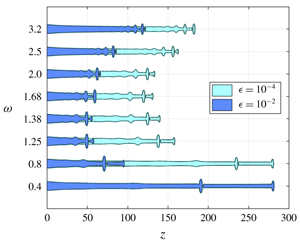Article contents
Frequency selection in a gravitationally stretched capillary jet in the jetting regime
Published online by Cambridge University Press: 29 April 2020
Abstract

A capillary jet falling under the effect of gravity continuously stretches while thinning downstream. We report here the effect of external periodic forcing on such a spatially varying jet in the jetting regime. Surprisingly, the optimal forcing frequency producing the most unstable jet is found to be highly dependent on the forcing amplitude. Taking benefit of the one-dimensional Eggers & Dupont (J. Fluid Mech., vol. 262, 1994, pp. 205–221) equations, we investigate the case through nonlinear simulations and linear stability analysis. In the local framework, the WKBJ (Wentzel–Kramers–Brillouin–Jeffreys) formalism, established for weakly non-parallel flows, fails to capture the nonlinear simulation results quantitatively. However, in the global framework, the resolvent analysis, supplemented by a simple approximation of the required response norm inducing breakup, is shown to correctly predict the optimal forcing frequency at a given forcing amplitude and the resulting jet breakup length. The results of the resolvent analysis are found to be in good agreement with those of the nonlinear simulations.
- Type
- JFM Papers
- Information
- Copyright
- © The Author(s), 2020. Published by Cambridge University Press
References
- 1
- Cited by


